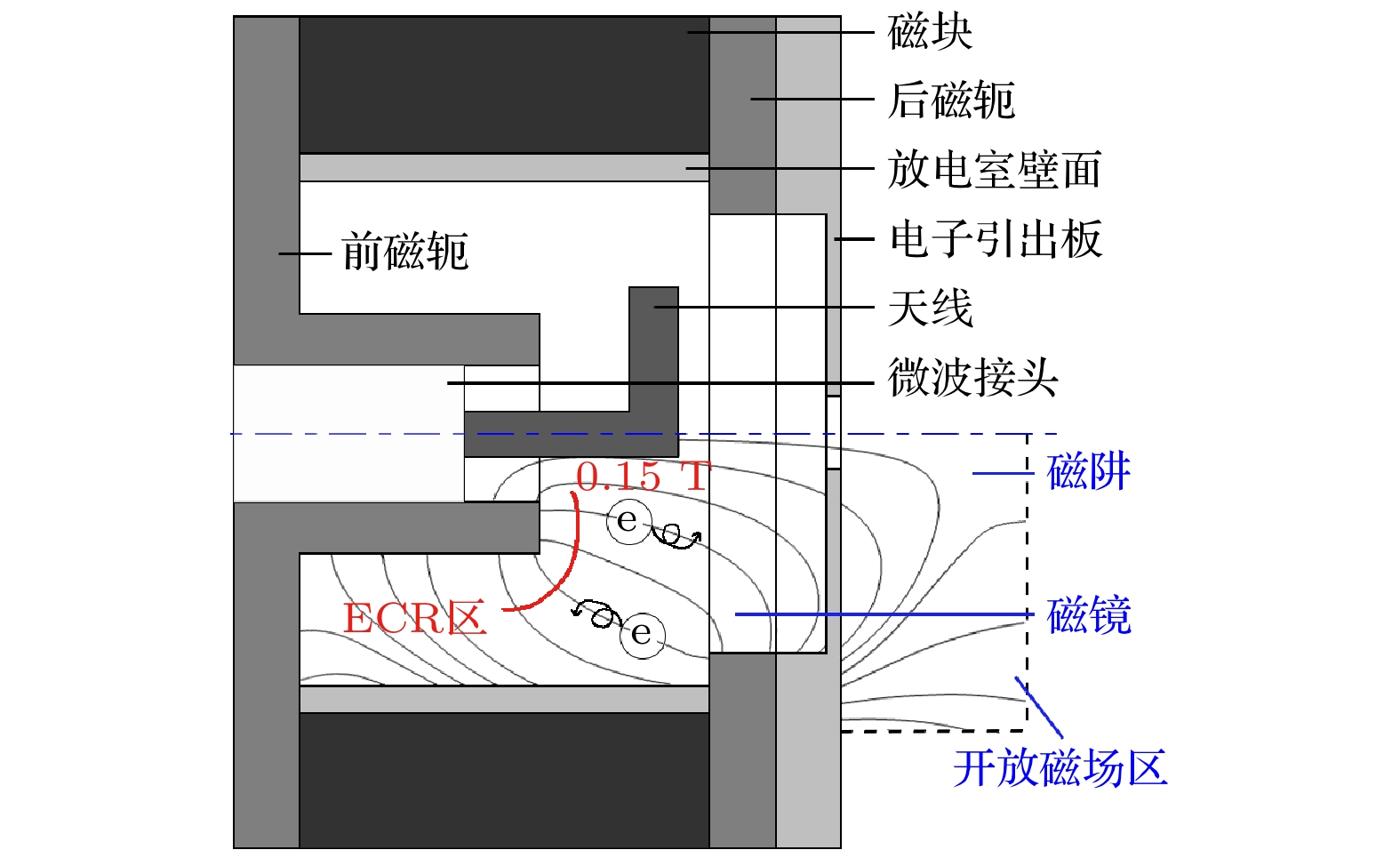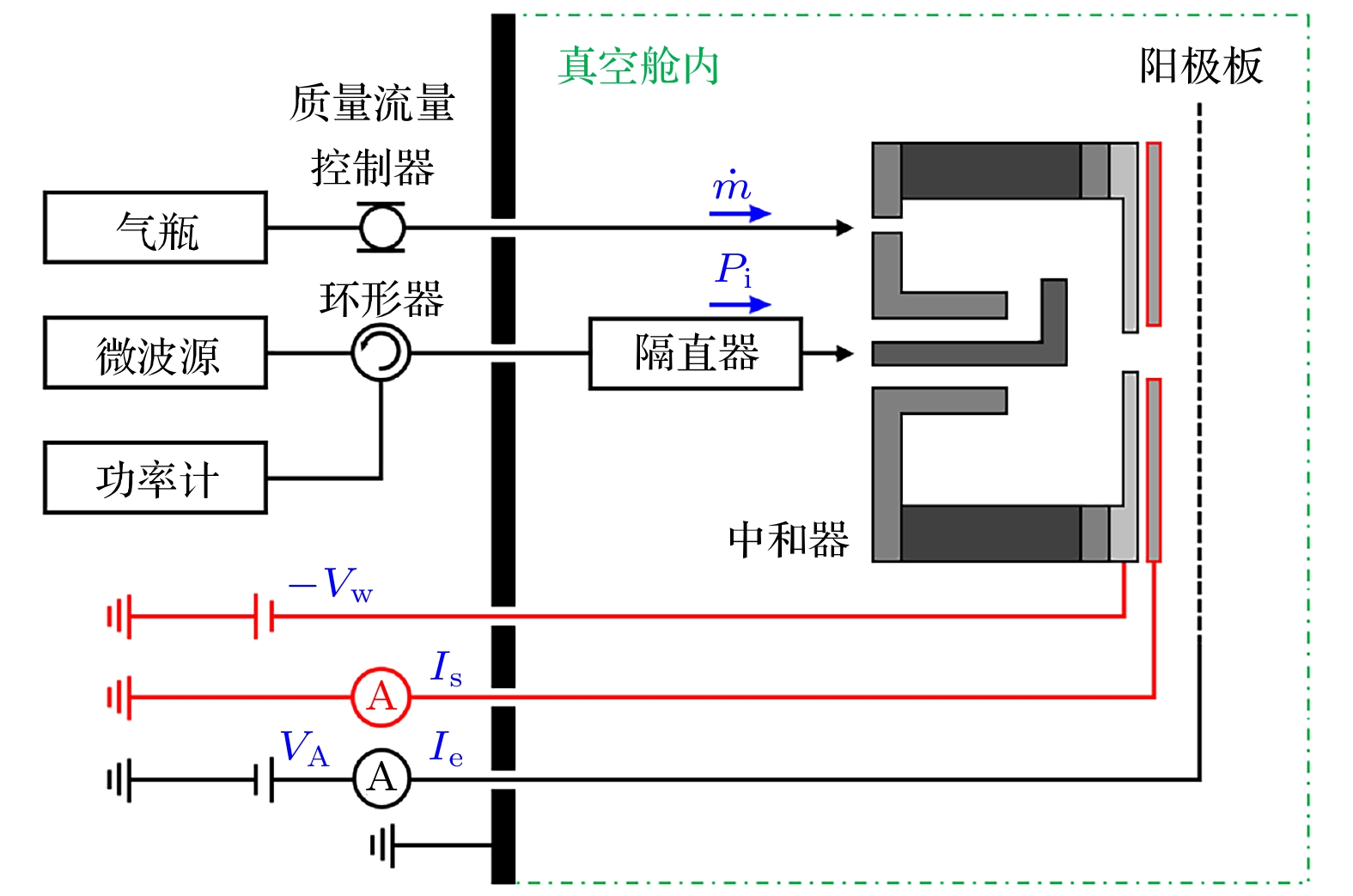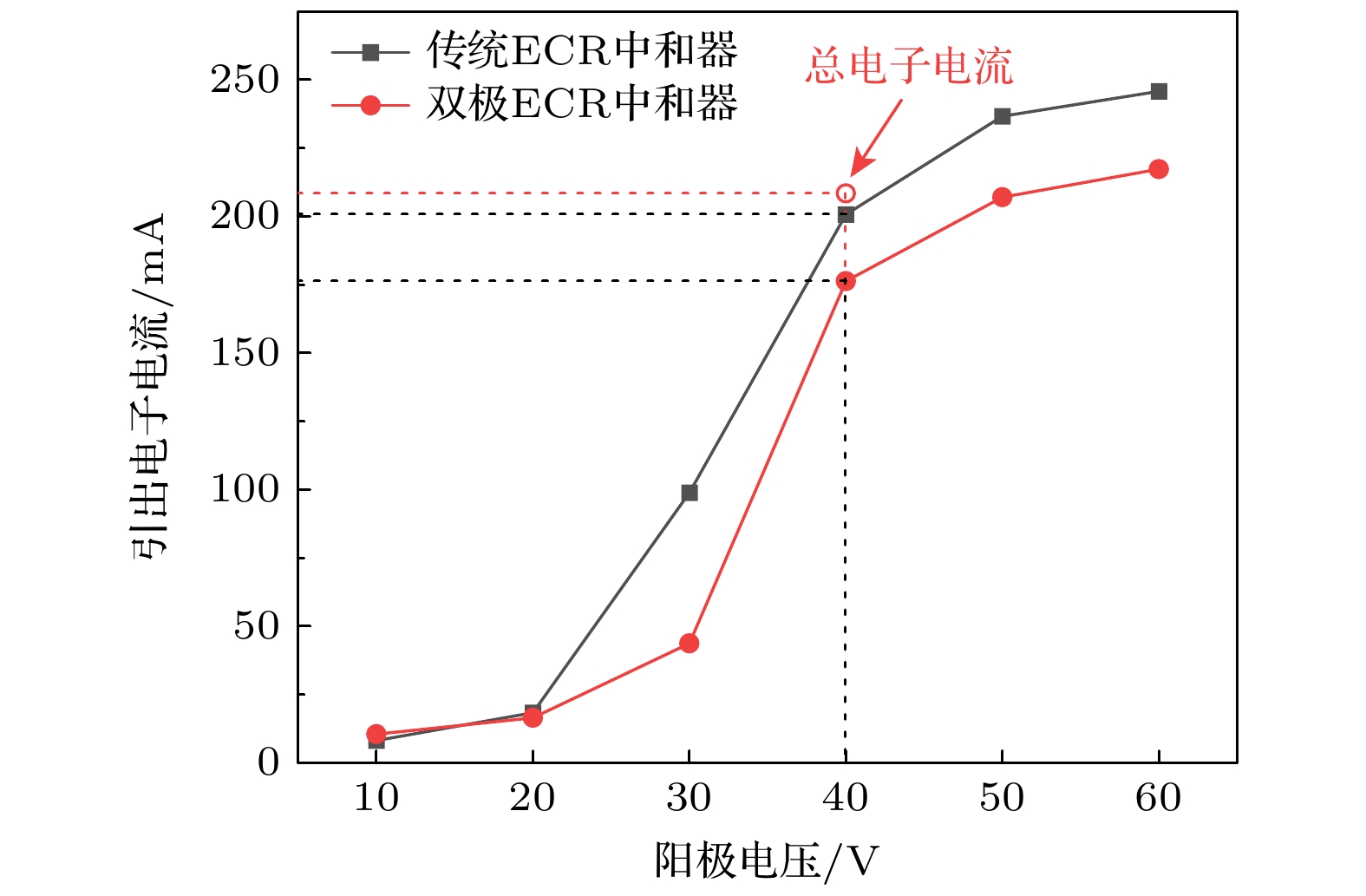-
10厘米电子回旋共振离子推力器(ECRIT)可以多类型气体工作, 应用于吸气式电推进系统具有可行性, 研究氮气工质ECRIT的ECR中和器是研究氮氧工质ECRIT的基础. 当传统氙气工质10厘米ECRIT的ECR中和器以氮气为工质工作时, 由于氮气分子量较低, 离子容易漂移出中和器, 引出电子电流减小, 已不适合以氮气为工质工作. 本文基于10厘米传统ECR中和器, 以抑制离子漂移出中和器、提升电子引出性能为目的, 实验研究适用于氮气工质工作的双极ECR中和器. 结果表明, 在气体质量流率0.04 mg/s、输入功率10 W的条件下, 以氮气为工质工作, 引出电子电流134 mA时, 传统ECR中和器所需的阳极电压为150 V, 而双极ECR中和器仅需50 V的阳极电压, 下降了约67%; 阳极电压40 V时, 传统ECR中和器的功率损耗为1204.82 W/A, 而双极ECR中和器的功率损耗为95.23 W/A, 约为前者的8.3%. 氮气工质双极ECR中和器的离子屏蔽效果显著, 电子引出性能得到改善.Electron cyclotron resonance ion thruster (ECRIT) with a diameter of 10 cm can be operated in multiple types of gases and it is feasible to be applied to air-breathing electric propulsion systems. The study on the neutralizer of the ECRIT running in nitrogen gas is the basis for the study on the ECRIT running in nitrogen-oxygen mixed gas. When the ECR neutralizer of typical 10-cm ECRIT running in xenon gas runs in nitrogen gas, the extracted electron current is reduced, because ions tend to drift out of the neutralizer, due to the lower molecular weight of nitrogen. The typical neutralizer is no longer suitable for running in nitrogen gas. In this work, based on the 10-cm typical ECR neutralizer, in order to inhibit ions drifting out of the neutralizer and improve the performance of electron extraction, a bipolar ECR neutralizer suitable for running in nitrogen gas is experimentally studied. The results show that under the conditions of gas mass flow rate of 0.04 mg/s and input power of 10 W, the anode voltage required by the typical ECR neutralizer running in nitrogen gas is 150 V when the extracted electron current is 134 mA. However, the bipolar ECR neutralizer requires only 50-V anode voltage, which decreases by about 67%. When the anode voltage is 40V, the power loss of the typical ECR neutralizer is 1204.82 W/A, while the power loss of the bipolar ECR neutralizer is 95.23 W/A, which is about 8.3% of the former. The ion shielding effect of the bipolar ECR neutralizer running on nitrogen gas is remarkable and the electron extraction performance is improved.
-
Keywords:
- electron cyclotron resonance /
- ion thruster /
- neutralizer /
- air-breathing electric propulsion
[1] 吴先明, 耿海, 贾连军, 蒲彦旭, 贺亚强, 王尚民, 李艳武 2022 真空与低温 28 26
 Google Scholar
Google Scholar
Wu X M, Geng H, Jia L J, Pu Y X, He Y Q, Wang S M, Li Y W 2022 Vacuum Cryog. 28 26
 Google Scholar
Google Scholar
[2] 袁春柱, 张强, 傅丹膺, 赵志明, 张永强, 张永贺, 陆文高, 姚远, 李瀛搏 2021 航天器工程 30 89
 Google Scholar
Google Scholar
Yuan C Z, Zhang Q, Fu D Y, Zhao Z M, Zhang Y Q, Zhang Y H, Lu W G, Yao Y, Li Y B 2021 Spacecr. Eng. 30 89
 Google Scholar
Google Scholar
[3] Marchioni F, Cappelli M A 2021 J. Appl. Phys. 130 053306
 Google Scholar
Google Scholar
[4] Shabshelowitz A 2013 Ph. D. Dissertation (America: University of Michigan)
[5] Hu P, Shen Y, Yao Z, Mao W, Hu Y, Liu X 2021 Vacuum 190 110275
 Google Scholar
Google Scholar
[6] Schönherr T, Komurasaki K, Romano F, Massuti-Ballester B, Herdrich G 2014 IEEE T. Plasma Sci. 43 287
 Google Scholar
Google Scholar
[7] Yukai M, Daiki K, Kazutaka N 2020 Proceedings of Space Transportation Symposium FY2019 (Sagamihara, Kanagawa Japan: Institute of Space and Astronautical Science, Japan Aerospace Exploration Agency (ISAS) (JAXA)) p002
[8] Yukai M, Kazutaka N Space Transportation Symposium FY2020 (Zoom, Japan: Institute of Space and Astronautical Science, Japan Aerospace Exploration Agency (ISAS) (JAXA)) p050
[9] Jackson S W, Marshall R 2017 J. Spacecr. Rockets 55 632
[10] 胡展 2021 硕士学位论文 (西安: 西北工业大学)
Hu Z 2021 M. S. Dissertation (Xi’an: Northwestern Polytechnical University) (in Chinese)
[11] Nishiyama K, Hosoda S, Tsukizaki R, Kuninaka H 2020 Acta Astronaut. 166 69
 Google Scholar
Google Scholar
[12] Kuninaka H, Nishiyama K, Funaki I, Yamada T, Shimizu Y, Kawaguchi J 2006 42nd AIAA/ASME/SAE/ASEE Joint Propulsion Conference & Exhibit (Sacramento, California: American Institute of Aeronautics and Astronautics) p4318
[13] Morishita T, Tsukizaki R, Morita S, Koda D, Nishiyama K, Kuninaka H 2019 Acta Astronaut. 165 25
 Google Scholar
Google Scholar
[14] Fu Y, Yang J, Jin Y, Xia X, Meng H 2019 Acta Astronaut. 164 387
 Google Scholar
Google Scholar
[15] Fu Y, Yang J, Geng H, Wu X, Hu Z, Xia X 2021 Vacuum 184 109932
 Google Scholar
Google Scholar
[16] 罗立涛, 杨涓, 金逸舟, 冯冰冰, 汤明杰 2015 西北工业大学学报 33 395
 Google Scholar
Google Scholar
Luo L T, Yang J, Jin Y Z, Feng B B, Tang M J 2015 J. Northwest. Polytech. Univ. 33 395
 Google Scholar
Google Scholar
[17] Meng H B, Yang J, Huang W B, Xia X, Fu Y L, Hu Z 2019 J. Astronaut. 12 1478 (in Chinese) [孟海波, 杨涓, 黄文斌, 夏旭, 付瑜亮, 胡展 2019 宇航学报 12 1478]
[18] Yang J, Fu Y, Liu X, Meng H, Jin Y 2018 Plasma Sci. Technol. 20 085402
 Google Scholar
Google Scholar
[19] Itikawa Y 2006 J. Phys. Chem. Ref. Data 35 31
 Google Scholar
Google Scholar
[20] Funaki I F I, Kuninaka H K H 2001 Jpn. J. Appl. Phys. 40 2495
 Google Scholar
Google Scholar
[21] Ren L, Wang Y, Ding W, Sun A, Karadag B, Deng Z, Geng J 2022 Rev. Sci. Instrum. 93 034501
 Google Scholar
Google Scholar
-
-
[1] 吴先明, 耿海, 贾连军, 蒲彦旭, 贺亚强, 王尚民, 李艳武 2022 真空与低温 28 26
 Google Scholar
Google Scholar
Wu X M, Geng H, Jia L J, Pu Y X, He Y Q, Wang S M, Li Y W 2022 Vacuum Cryog. 28 26
 Google Scholar
Google Scholar
[2] 袁春柱, 张强, 傅丹膺, 赵志明, 张永强, 张永贺, 陆文高, 姚远, 李瀛搏 2021 航天器工程 30 89
 Google Scholar
Google Scholar
Yuan C Z, Zhang Q, Fu D Y, Zhao Z M, Zhang Y Q, Zhang Y H, Lu W G, Yao Y, Li Y B 2021 Spacecr. Eng. 30 89
 Google Scholar
Google Scholar
[3] Marchioni F, Cappelli M A 2021 J. Appl. Phys. 130 053306
 Google Scholar
Google Scholar
[4] Shabshelowitz A 2013 Ph. D. Dissertation (America: University of Michigan)
[5] Hu P, Shen Y, Yao Z, Mao W, Hu Y, Liu X 2021 Vacuum 190 110275
 Google Scholar
Google Scholar
[6] Schönherr T, Komurasaki K, Romano F, Massuti-Ballester B, Herdrich G 2014 IEEE T. Plasma Sci. 43 287
 Google Scholar
Google Scholar
[7] Yukai M, Daiki K, Kazutaka N 2020 Proceedings of Space Transportation Symposium FY2019 (Sagamihara, Kanagawa Japan: Institute of Space and Astronautical Science, Japan Aerospace Exploration Agency (ISAS) (JAXA)) p002
[8] Yukai M, Kazutaka N Space Transportation Symposium FY2020 (Zoom, Japan: Institute of Space and Astronautical Science, Japan Aerospace Exploration Agency (ISAS) (JAXA)) p050
[9] Jackson S W, Marshall R 2017 J. Spacecr. Rockets 55 632
[10] 胡展 2021 硕士学位论文 (西安: 西北工业大学)
Hu Z 2021 M. S. Dissertation (Xi’an: Northwestern Polytechnical University) (in Chinese)
[11] Nishiyama K, Hosoda S, Tsukizaki R, Kuninaka H 2020 Acta Astronaut. 166 69
 Google Scholar
Google Scholar
[12] Kuninaka H, Nishiyama K, Funaki I, Yamada T, Shimizu Y, Kawaguchi J 2006 42nd AIAA/ASME/SAE/ASEE Joint Propulsion Conference & Exhibit (Sacramento, California: American Institute of Aeronautics and Astronautics) p4318
[13] Morishita T, Tsukizaki R, Morita S, Koda D, Nishiyama K, Kuninaka H 2019 Acta Astronaut. 165 25
 Google Scholar
Google Scholar
[14] Fu Y, Yang J, Jin Y, Xia X, Meng H 2019 Acta Astronaut. 164 387
 Google Scholar
Google Scholar
[15] Fu Y, Yang J, Geng H, Wu X, Hu Z, Xia X 2021 Vacuum 184 109932
 Google Scholar
Google Scholar
[16] 罗立涛, 杨涓, 金逸舟, 冯冰冰, 汤明杰 2015 西北工业大学学报 33 395
 Google Scholar
Google Scholar
Luo L T, Yang J, Jin Y Z, Feng B B, Tang M J 2015 J. Northwest. Polytech. Univ. 33 395
 Google Scholar
Google Scholar
[17] Meng H B, Yang J, Huang W B, Xia X, Fu Y L, Hu Z 2019 J. Astronaut. 12 1478 (in Chinese) [孟海波, 杨涓, 黄文斌, 夏旭, 付瑜亮, 胡展 2019 宇航学报 12 1478]
[18] Yang J, Fu Y, Liu X, Meng H, Jin Y 2018 Plasma Sci. Technol. 20 085402
 Google Scholar
Google Scholar
[19] Itikawa Y 2006 J. Phys. Chem. Ref. Data 35 31
 Google Scholar
Google Scholar
[20] Funaki I F I, Kuninaka H K H 2001 Jpn. J. Appl. Phys. 40 2495
 Google Scholar
Google Scholar
[21] Ren L, Wang Y, Ding W, Sun A, Karadag B, Deng Z, Geng J 2022 Rev. Sci. Instrum. 93 034501
 Google Scholar
Google Scholar
计量
- 文章访问数: 6022
- PDF下载量: 88
- 被引次数: 0














 下载:
下载:













